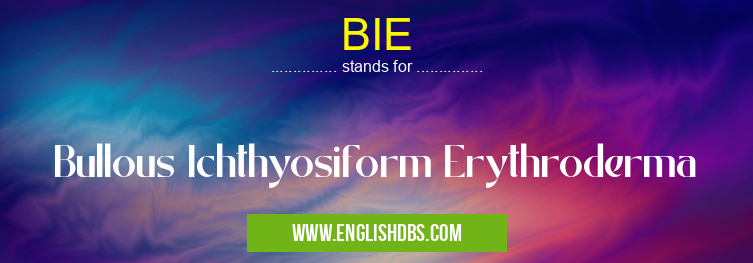What does BIE mean in UNCLASSIFIED
Bullous Ichthyosiform Erythroderma (BIE) is a rare skin disorder that causes the formation of blisters on the body, resulting in thickened and dry patches of skin that often have a fish-like appearance. This condition can be present at birth or develop later in life. It is caused by mutations in the genes involved in keratin production and affects only about 3 out of every 1 million people worldwide. BIE is typically diagnosed based on signs and symptoms observed during physical examination, though other tests are sometimes necessary to rule out similar conditions. Treatments for this condition include topical medications, phototherapy, and systemic medications to reduce inflammation and slow the progression of the disease.

BIE meaning in Unclassified in Miscellaneous
BIE mostly used in an acronym Unclassified in Category Miscellaneous that means Bullous Ichthyosiform Erythroderma
Shorthand: BIE,
Full Form: Bullous Ichthyosiform Erythroderma
For more information of "Bullous Ichthyosiform Erythroderma", see the section below.
Meaning of BIE
BIE stands for Bullous Ichthyosiform Erythroderma, which is a rare skin condition that involves blistering of the skin along with thickening, scaling and dryness with a fish scale pattern that may occur from birth or develop later in life. It is usually caused by mutations in genes associated with producing keratin proteins which leads to disruption of the epidermal barrier function as well as potential problems such as infection and inflammation.
Symptoms & Diagnosis
The most common symptom associated with BIE is blistering on the skin, which may be accompanied by red patches or scales. Blistering typically occurs on large areas of skin rather than individual spots or lesions. Other symptoms include itching, scaling, discoloration, increased sensitivity to sunlight, patchy hair loss and an abnormally thickened dermis layer of skin. A diagnosis for BIE can be made through physical examination based on visual signs and symptoms as well as laboratory testing that looks at genetic abnormalities associated with BIE.
Treatment Options
Treatment options for BIE depend largely upon its severity but generally includes topical medications such as corticosteroids to reduce inflammation; antibiotics to treat any secondary infection; phototherapy to help reduce scaling; systemic medications including retinoids; antifungals to manage fungal infections; topical coal tar preparations; moisturizing creams or ointments; lifestyle changes such as wearing protective clothing when going outside or avoiding direct sun exposure.
Essential Questions and Answers on Bullous Ichthyosiform Erythroderma in "MISCELLANEOUS»UNFILED"
What is Bullous Ichthyosiform Erythroderma?
Bullous Ichthyosiform Erythroderma (BIE) is a skin condition characterized by large, fluid-filled blisters. It typically appears on the neck, shoulders, back, and lower legs. This condition usually affects newborns but can sometimes appear in adults. BIE is a rare condition that can be caused by an inherited gene mutation or an underlying immune system disorder
Are there different types of Bullous Ichthyosiform Erythroderma?
Yes, there are three main types of BIE: epidermolytic hyperkeratosis, nonbullous ichthyosiform erythroderma and congenital hemidysplasia with ichthyosiform nevi and limb defects (CHILD).
What are the symptoms of Bullous Ichthyosiform Erythroderma?
The primary symptom of BIE is large, fluid-filled blisters which typically appear on the neck, shoulders, back and lower extremities. In some cases these blisters may become dry and flaky over time. Other symptoms include redness and scaling of the skin as well as changes in texture or thickness of the skin.
How is Bullous Ichthyosiform Erythroderma diagnosed?
Usually BIE can be diagnosed based on its characteristic blistering rash. However diagnosis may also require a detailed medical history as well as laboratory tests to check for underlying genetic mutations or immune system problems. A biopsy may also be used to confirm a diagnosis in some cases.
What treatment options are available for Bullous Ichthyosiform Erythroderma?
Treatment for BIE usually involves oral medications such as retinoids or steroids to reduce inflammation and blistering as well as topical creams used to keep the affected areas moisturized and protected from infections. In some cases laser treatments may also be used if other treatments fail to provide relief from symptoms.
Is there a cure for Bullous Ichthyosiform Erythroderma?
Unfortunately there is no cure for BIE at this time however there are treatments available which can help manage symptoms and prevent infection from developing due to broken skin or open blisters.
Does having Bullous Ichthyosiform Erythroderma put me at risk for other diseases?
People with BIE may have weakened immune systems which puts them at an increased risk for certain infections such as impetigo or cellulitis.
Final Words:
BIE is a rare disorder that causes blistering along with thickening and dryness of the affected area of skin. It is usually caused by mutations in genes involved in keratin production which leads to abnormalities in those cells responsible for maintaining healthy epidermal barrier functions thus leading to possible issues such as increased risk for infection and inflammation. Diagnosis can usually be made through physical examination combined with laboratory testing while treatments range from topical medications, systemic medications like retinoids, phototherapy, lifestyle changes such as avoiding direct sunlight exposure when possible.
